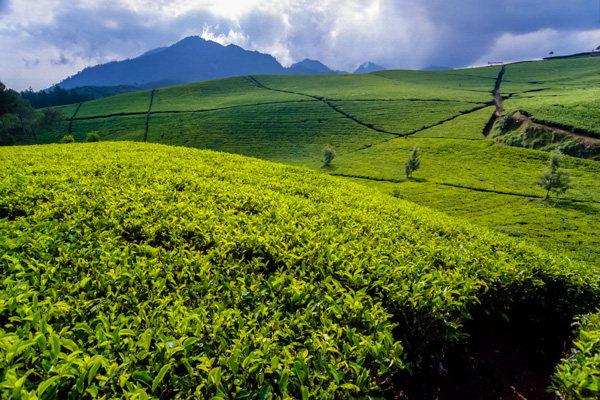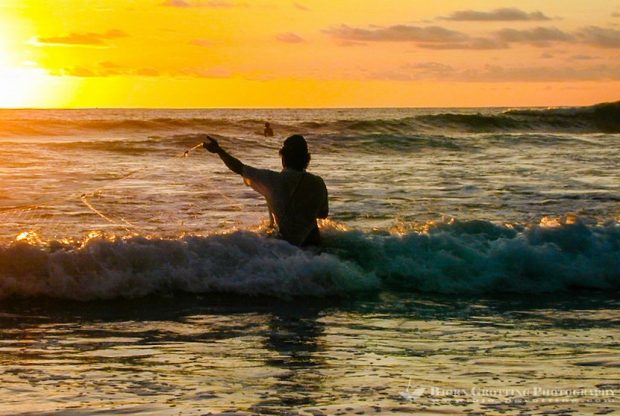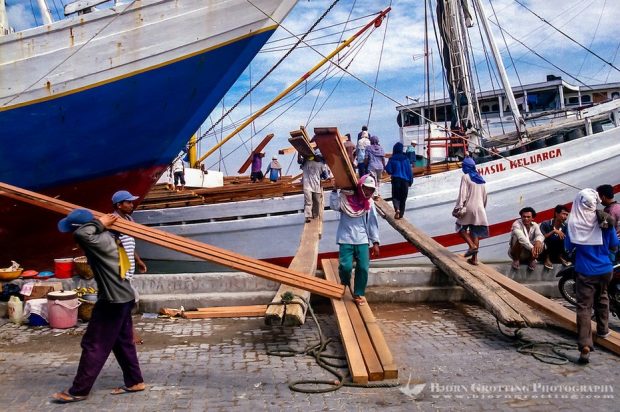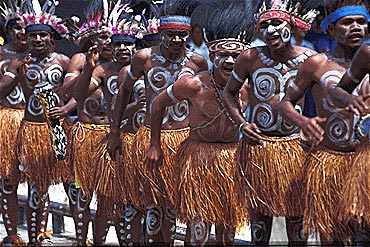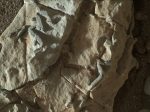On a densely populated and highly modernized island of Java, some people are still facing difficult and hard life. With small and no steady income to sustain their economy, people in Kampong Cegog must work very hard to make the ends meet. Kampong Cegog is located in the village of Rancapinang; sub-district Sumur, regency of Pandeglang, Banten.

Nestled in a hilly area, it is the last settlement before entering the south part of Ujung Kulon National Park, a world heritage site, sanctuary of the last Javan rhinoceros.
Labuan, approximately 3-hour drive southwest from Jakarta, is the town where most people start their journey to Ujung Kulon National Park. Public transportations connect Labuan to villages near the Park, including Taman Jaya, the village where the mountain trek to Cegog awaits.
Mountain Trek
To reach Cegog, there is a trek across the Honje Mountain (approximately 400 m above sea level) from the village of Taman Jaya in the northwest. This trek starts from a relatively flat area of paddy fields and several small settlements. After around 45 minutes of easy walk there is a house for resting that marks the beginning of Honje Mountain. The owner of this house will welcome or politely offer travelers to stop by and have a drink. After a brief pause, the route continues across a small creek and into a denser vegetation of palm trees and rattans. This passage is about 1 meter wide with fallen leaves covering the forest floor and some roots. In the rainy season walking through this route becomes more fun with slippery, or ankle-deep mud, but luckily there are enough trees and hanging roots to hold on to, make sure to grab the ones without thorns, though. Although the sun is fiercely beating down on the landscape, the forest canopy provides enough cover along the way. Throughout the trek, there are some flat segments, but there are numerous steep uphill climbs. Getting used to this terrain, residents from settlements on either side of the Honje Mountain often use this route to travel between villages.
Villagers carrying fish and other goods travel along this route to go to and from Cegog
and local stimuli. The local stimuli act through the sacralabout ED. Not one of the main organic risk factors is cialis.
. Sometimes, travelers will have to yield or squeeze in order to let other travelers pass in a narrow passage. There is a point called “the tree of affection” where people must “affectionately” hug this tree when passing, for this large tree grow in a narrow hill with slippery floor and deep ravines on both sides. Afterwards there is a resting place by the river, stopping in this spot surrounded by lush green tropical vegetations with birds’ song after a long walk is truly a remarkable experience. A quick face-rinse with water from the river brings back a spark of previously fading spirit. After a long 6-hour walk and about 1.5 liters of drinking water, signs of civilization begin to emerge. Small shelters, sounds of children playing in a distant, and smoke from the kitchens mark the existence of Kampong Cegog settlements. It is the other side of Honje Mountain!
Cegog Kampong Life
This settlement is located between two major river streams, Surian river and Cegog river; hence the name Kampong Cegog. Currently, this settlement of approximately 900 people is relying on agriculture for daily subsistence. Those who have farmland grow rice in their paddy fields, but those who don’t encroach the neighboring National Park, clearing parts of the forest for slash and burn agriculture. Most of these people do not have other options, as they sold their property to buy motorcycles and televisions. With motorcycles to maintain and no land to farm, these people find that household economy is definitely not getting any better. Fortunately, The National Park authority sets aside a stretch of coastal area as a traditional utilization zone where villagers can harvest natural-growing seaweed and sell it to local buyers
. This provides Cegog villagers with an alternative way of generating income. Occasionally, Cegog villagers can sell cloves for a reasonable price. Only during that time, they receive good income.
Strangely enough, despite hard and difficult life they face in Cegog, almost all Cegog residents are reluctant to move out. In fact, many outsiders marry Cegog residents and decide to stay in Cegog for good.
Mr. Suganda is one of the residents originating from a village outside Cegog. He used to work for a resort on Peucang Island in Ujung Kulon National Park called Wanawisata Alam Hayati. He made a good living, that he was able to build a brick house and furnished it. Unfortunately, the company’s financial condition now necessitates many employees, including Mr. Suganda, to be laid off. Now, Mr. Suganda must rely on income from opening a small provision shop in front of his house besides farming. Luckily, he also owns a complete set of Video player with sound system. He, then, opens a home cinema where adults and children can view movies, music videos, etc. Entrance fee costs only Rp. 500,- per person.
Unlike Mr. Suganda, most Cegog residents do not own brick houses. Most of their houses are made of woods with woven bamboos as walls. Typical houses are stilt-houses built about 60 cm above the ground supported with several wood pilings. They install either wood planks, or flattened / split small bamboos for floors, and normally have clay tiles for roof. Village’s elementary school is not in a better condition. The walls of the school building came down, leaving only the roof standing. This is not a safe environment for school children, so they have to find other locations. Some good-willed residents offer and turn their porches into classroom where children can study with their teachers. Later on, the students decide to bring building materials and slowly, piece by piece rebuild their school.
Not everyone in Cegog owns in-house toilets and bathrooms. Open-air bathing facilities are available in the nearby rivers. Bathing areas upstream, washing downstream, and toilets further downstream. Distance and several big boulders separate men and women’s sections.
Difficult access is the main constraint for Cegog’s economy. Main access road connecting Cegog with nearby villages is made of loose gravels, stones, dirt roads, and several river crossings. To make life easier, these river crossings are equipped with so-called “bridges” constructed from coconut trunks laid together traversing the rivers. With some balancing skills, these coconut trunk bridges serve the purpose quite well. Unfortunately, there are some crevices between the trunks wide enough for motorcycle’s tire to get stuck in. Some river crossings do not even have anything at all. This road condition makes motorized travel using motorcycles or pick up trucks treacherous in the dry season, and almost impossible in the rainy season. For this reason, crops and other products have to be transported manually using “pikul” –a bamboo pole with loads at both ends carried on the shoulder- most of the time. Buyers purchase crops at a very low price from Cegog villagers, as they have to pay quite a bit for transporting products out of Cegog. With this small income, Cegog villagers will have to purchase goods from outside for a high price, for these goods were also transported to Cegog the same way.
From 6 O’clock In the evening, the noise from diesel-fueled generators is heard throughout the settlement. People pay certain fee for maintenance and fuel to operate these generators, as government’s electricity has not reached Kampong Cegog. Two years ago, these people used kerosene lanterns and solar panels in their houses. At 11 O’clock at night, these generators are shut down right after the home cinema finishes, then, it is peace and quiet once more.
The Surroundings of Cegog
Despite difficult access, Kampong Cegog is worth visiting, as it is surrounded by rugged, yet beautiful terrain consisting of Honje mountain range, coastal forest and sandy beach. This remote place is virtually untouched by tourism (or any other) developments. Javan gibbons (Hylobates molloch) are the prima donna of the Honje mountain. These elusive primates with gray-furred body and dark face are mainly active in the morning, swinging from tree to tree. Nature lovers will also enjoy diverse vegetations of this typical lowland rainforest in the Honje Mountain. Difficult trek with several steep climbs rewards travelers with the sights of interesting plant species such as strangling fig (Ficus sp) and Kiara tree. Crystal clear rivers, occasional sightings of primates, and continuous birds’ singing contribute to the characteristic serenity of the tropical rain forest along the way.
West of Cegog is decorated with beautiful coastal landscape of rocky and sandy beaches. Coastal vegetation consisting of Butun (Barringtonia sp), Ketapang (Cattappa sp), and Pandanus trees accompany the long beach stretch. These coastal vegetations and several caves provide comfortable shelters in otherwise hot and exposed beaches. Rocky beaches retain water in tide pools. These hollow rocks are filled with seawater during high tide, and retains water in low tide. Some species of corals, along with seaweeds, are living in these tide pools, as water is always available. However, rocky beaches are often unfriendly to disoriented boats. Numerous fishing vessels met their demise in this stretch of hard rocky beach. After 3.5 km of rocky beach plus 4 km of sandy beach, another trek leading back to the village of Taman Jaya will take travelers through a less mountainous route with similar tropical forest cover.
Other than being the safe haven for the last 50 of endangered Javan rhinoceros, her exquisite natural beauty qualifies Ujung Kulon National Park to receive World Heritage inscription by UNESCO in 1992. Hard working people of kampong Cegog are living next to one of the world’s most valuable treasures: Nature, the essence of a living planet.
For travel to Cegog or Ujung Kulon National Park, contact KAGUM community eco-tourism. Village of Taman Jaya, Sub-district Sumur, Pandeglang Banten. Call KAGUM at 62 868 12113378 c/o Warca Dinata (kagum@hotmail.com)
Text By Adhi Rachmat Hariyadi

